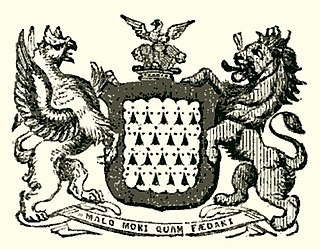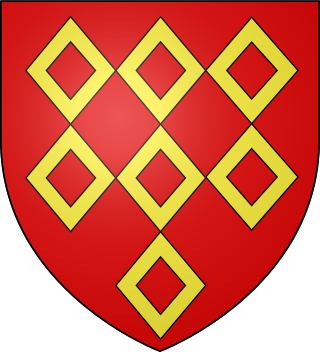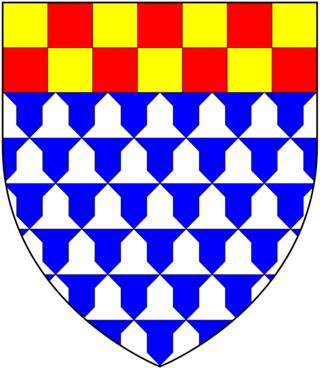

Baron Slane was a title in the Peerage of Ireland. It was created in 1370 for the Fleming family but forfeited in 1691.


Baron Slane was a title in the Peerage of Ireland. It was created in 1370 for the Fleming family but forfeited in 1691.
The Flemings of Slane descend from Erchenbald, otherwise referred to as "Archembald le Fleming",[ citation needed ] of Bratton Fleming, Devon, who was alive in 1087. Archembald derived his surname due to his birth in Flanders, and came to England during the reign of William I.[ citation needed ] He was succeeded by his son, Stephen (fl. 1145), whose son, Archembald, arrived in Ireland with Henry II in 1171 and participated in Hugh de Lacy's plantation of the Kingdom of Mide. On the west side of the hill of Slane, there are the remains of a 12th-century motte and bailey which was the settlement, destroyed by the Irish in 1176.
Succeeding Flemings were Stephen, (died c. 1213–1214) and Baldwin (died 1260). Baldwin's son, Richard, is the first of whom some substantial information exists. He married Mary/Maria Martin, daughter of Sir Nicholas FitzMartin the Younger (died 1260). Richard died in 1301, but it is unknown when his wife died. Their son, Baldwin (died 1335), married Matilda/Maude de Genville, daughter of Sir Simon de Genville of Trim. They were the parents of Simon Fleming, 1st Baron Slane, who died on 13 September 1370.
An unusual feature of the title was the ability of the holder to petition the Crown to transfer it: after the death of the 12th Baron in 1625, the 13th Baron successfully petitioned the Crown to transfer the title to his younger brother, since as a Roman Catholic priest he did not expect to live on or manage the family estate. He later became Roman Catholic Archbishop of Dublin.
The 17th Baron, Christopher, was attainted in 1691 for fighting against William III. The title became dormant after the death of the 19th Baron in 1771.
After the title became dormant, claimants from junior lines continued to advance their claims into the 19th century. One such was James Ellis Fleming of Tuam, County Galway, who, in 1824, claimed descent from John, third son of Christoper, who had succeeded in 1612. In the case "Slane Peerage case" brought before the House of Lords in 1835, evidence was submitted by the agent of the petitioner. [2] The title remains dormant.

Earl of Longford is a title that has been created twice in the Peerage of Ireland.

Earl of Devon was created several times in the English peerage, and was possessed first by the de Redvers family, and later by the Courtenay family. It is not to be confused with the title of Earl of Devonshire, held, together with the title Duke of Devonshire, by the Cavendish family of Chatsworth House, Derbyshire, although the letters patent for the creation of the latter peerages used the same Latin words, Comes Devon(iae). It was a re-invention, if not an actual continuation, of the pre-Conquest office of Ealdorman of Devon.

Earl Ferrers is a title in the Peerage of Great Britain. It was created in 1711 for Robert Shirley, 14th Baron Ferrers of Chartley. The Shirley family descends from George Shirley of Astwell Castle, Northamptonshire. In 1611 he was created a Baronet, of Staunton Harold in the County of Leicester, in the Baronetage of England. He was succeeded by his son Henry, the second Baronet, who married Lady Dorothy Devereux, daughter of Robert Devereux, 2nd Earl of Essex. On the death of her brother Robert Devereux, 3rd Earl of Essex, she became the youngest co-heir to the baronies of Ferrers of Chartley and the barony of Bourchier, which had fallen into abeyance on the death of the third Earl. Shirley was succeeded by his eldest son, the third Baronet. He died unmarried and was succeeded by his younger brother, the fourth Baronet. He was imprisoned in the Tower of London by Cromwell and died there in 1656. On his death the title passed to his eldest son, the fifth Baronet. He died at an early age and was succeeded at birth by his posthumous son, the sixth Baronet.

Baron le Despencer is a title that has been created several times by writ in the Peerage of England.
Earl of Clancarty is a title that has been created twice in the Peerage of Ireland.

Baron Trimlestown, of Trimlestown in County Meath, is a title in the Peerage of Ireland.

Baron Grey de Wilton is a title that has been created twice, once in the Peerage of England (1295) and once in the Peerage of Great Britain (1784). The first creation was forfeit and the second creation is extinct.

Baron Ferrers of Groby was a title in the Peerage of England. It was created by writ on 29 December 1299 when William Ferrers, 1st Baron Ferrers of Groby was summoned to parliament. He was the son of Sir William de Ferrers, Knt., of Groby, Leicestershire, (d.1287) by his first wife Anne Durward, 2nd daughter of Alan Durward and his wife Margery of Scotland, and grandson of William de Ferrers, 5th Earl of Derby. The first Baron was married to Ellen de Menteith, daughter of Alexander, Earl of Menteith. In 1475 the eighth baron was created the Marquess of Dorset, and the barony in effect merged with the marquessate. It was forfeited along with the marquessate when the third marquess was attainted in 1554.
The title Baron Ferrers of Chartley was created on 6 February 1299 for John de Ferrers, son of Robert de Ferrers, 6th Earl of Derby. The daughter of the 6th Baron Ferrers of Chartley, Anne, married Walter Devereux who was summoned to parliament as Lord Ferrers in her right. Their descendants became Earls of Essex and the peerage was forfeited in 1601 on the attainder of Robert Devereux, 2nd Earl of Essex, but restored to his son Robert in 1604, on whose death in 1646 the peerage fell into abeyance. The abeyance was terminated in 1677 when Robert Shirley, a grandson of one of the sisters of the 3rd Earl of Essex, was summoned as Lord Ferrers of Chartley with precedence to the original creation. In 1711, Shirley was created the 1st Earl Ferrers, but the Earldom and Barony separated at his death, the barony going to Elizabeth Shirley, the daughter of his eldest son, while the earldom went to his second son. On the 1741 death of Elizabeth Shirley, 15th Baroness Ferrers of Chartley and wife of the Earl of Northampton, the peerage again briefly fell into an abeyance that was resolved in 1749 by the death of two of the three heiresses, leaving the surviving daughter, Charlotte Compton, wife of the Marquess Townshend, as 16th Baroness Ferrers of Chartley. The barony continued, merged with the marquessate, until the death of George Ferrars Townshend, 3rd Marquess Townshend in 1855, when it again fell into abeyance between his two sisters and their heirs. It remains in abeyance.

Simon Fleming is the first Baron Slane whose holding of the title can be conclusively established.
James Fleming was an Irish nobleman, who sat as a member of the House of Lords in the Irish Parliament in 1491 and also served as High Sheriff of Meath.
Thomas Fleming was an Irish peer, and a member of the Parliament of Ireland of 1585. He was the son of James Fleming, and great-grandson of James Fleming, 7th Baron Slane. His mother was Ismay Dillon, daughter of Sir Bartholomew Dillon, Lord Chief Justice of Ireland and his first wife Elizabeth Barnewall; after his father's death she remarried Sir Thomas Barnewall of Trimlestown.

Christopher Fleming, 1st Viscount Longford and 17th Baron Slane (1669–1726), was an Irish peer and a member of the Irish parliament of 1689.
James Ellis Fleming was an Irish claimant to the title of 20th Baron Slane.

The MacCarthy dynasty of Muskerry is a tacksman branch of the MacCarthy Mor dynasty, the Kings of Desmond.
Baron Astley (1295) was created by writ of summons dated 23 June 1295 for a family which had lived at Astley, Warwickshire, England since the time of Henry I. Sir Thomas de Astley who was killed in the Battle of Evesham in 1265 married twice. From Sir Thomas's first marriage to Joan de Blois descended the Barons Astley.
The Manor of Bratton Fleming was a medieval manor estate in Bratton Fleming, Devon, England.

Ash in the parish of Braunton in North Devon is a historic estate listed in the Domesday Book. The present mansion, known as The Ash Barton estate is a Grade II* listed building.
The manor of Alverdiscott was a manor situated in north Devon, England, which included the village of Alverdiscott.
Erchenbald or Archembald was a mesne lord listed in the Domesday Book of 1086 as a tenant of nine manors in Devon and Cornwall, England. He is believed to be the first English ancestor of the prominent Fleming family.
dillon fleming bratton.